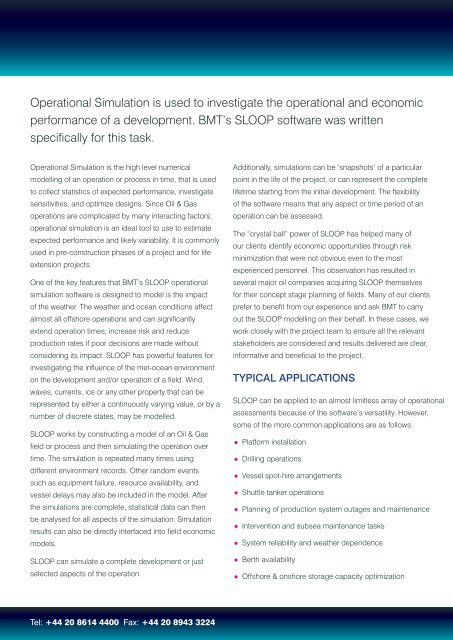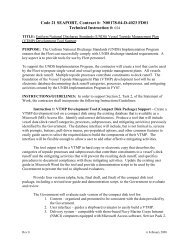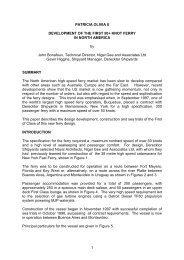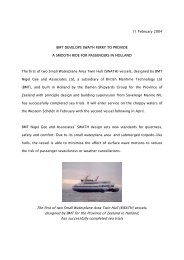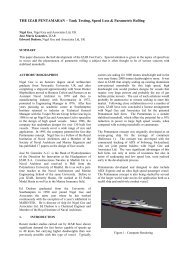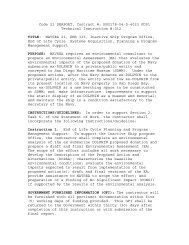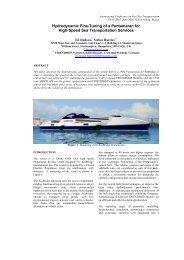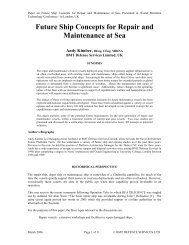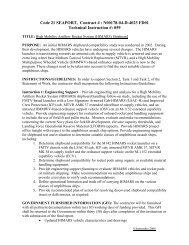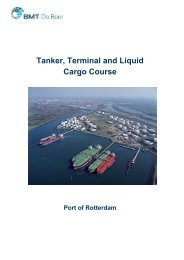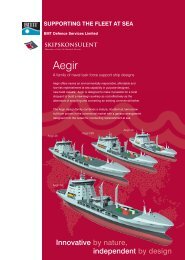Operational Simulation brochure - BMT Fluid Mechanics
Operational Simulation brochure - BMT Fluid Mechanics
Operational Simulation brochure - BMT Fluid Mechanics
- No tags were found...
You also want an ePaper? Increase the reach of your titles
YUMPU automatically turns print PDFs into web optimized ePapers that Google loves.
<strong>Operational</strong> <strong>Simulation</strong> is used to investigate the operational and economic<br />
performance of a development. <strong>BMT</strong>’s SLOOP software was written<br />
specifically for this task.<br />
<strong>Operational</strong> <strong>Simulation</strong> is the high level numerical<br />
modelling of an operation or process in time, that is used<br />
to collect statistics of expected performance, investigate<br />
sensitivities, and optimize designs. Since Oil & Gas<br />
operations are complicated by many interacting factors,<br />
operational simulation is an ideal tool to use to estimate<br />
expected performance and likely variability. It is commonly<br />
used in pre-construction phases of a project and for life<br />
extension projects.<br />
One of the key features that <strong>BMT</strong>’s SLOOP operational<br />
simulation software is designed to model is the impact<br />
of the weather. The weather and ocean conditions affect<br />
almost all offshore operations and can significantly<br />
extend operation times, increase risk and reduce<br />
production rates if poor decisions are made without<br />
considering its impact. SLOOP has powerful features for<br />
investigating the influence of the met-ocean environment<br />
on the development and/or operation of a field. Wind,<br />
waves, currents, ice or any other property that can be<br />
represented by either a continuously varying value, or by a<br />
number of discrete states, may be modelled.<br />
SLOOP works by constructing a model of an Oil & Gas<br />
field or process and then simulating the operation over<br />
time. The simulation is repeated many times using<br />
different environment records. Other random events<br />
such as equipment failure, resource availability, and<br />
vessel delays may also be included in the model. After<br />
the simulations are complete, statistical data can then<br />
be analysed for all aspects of the simulation. <strong>Simulation</strong><br />
results can also be directly interfaced into field economic<br />
models.<br />
SLOOP can simulate a complete development or just<br />
selected aspects of the operation.<br />
Additionally, simulations can be ‘snapshots’ of a particular<br />
point in the life of the project, or can represent the complete<br />
lifetime starting from the initial development. The flexibility<br />
of the software means that any aspect or time period of an<br />
operation can be assessed.<br />
The “crystal ball” power of SLOOP has helped many of<br />
our clients identify economic opportunities through risk<br />
minimization that were not obvious even to the most<br />
experienced personnel. This observation has resulted in<br />
several major oil companies acquiring SLOOP themselves<br />
for their concept stage planning of fields. Many of our clients<br />
prefer to benefit from our experience and ask <strong>BMT</strong> to carry<br />
out the SLOOP modelling on their behalf. In these cases, we<br />
work closely with the project team to ensure all the relevant<br />
stakeholders are considered and results delivered are clear,<br />
informative and beneficial to the project.<br />
Typical Applications<br />
SLOOP can be applied to an almost limitless array of operational<br />
assessments because of the software’s versatility. However,<br />
some of the more common applications are as follows:<br />
• Platform installation<br />
• Drilling operations<br />
•<br />
•<br />
•<br />
•<br />
•<br />
• Berth availability<br />
•<br />
Vessel spot-hire arrangements<br />
Shuttle tanker operations<br />
Planning of production system outages and maintenance<br />
Intervention and subsea maintenance tasks<br />
System reliability and weather dependence<br />
Offshore & onshore storage capacity optimization<br />
The<br />
Key benefits<br />
• Productivity and downtime of a new or modified<br />
development<br />
• Influence of weather limitations on the performance of<br />
the system as a whole<br />
• Weather limits on loading or discharge<br />
• Weather effects on transit times<br />
• Assess contractual delivery obligations<br />
•<br />
•<br />
Sensitivity of operational performance to uncertainties<br />
Select robust strategies that deliver high net present<br />
value at an acceptable level of financial risk<br />
SLOOP Software<br />
SLOOP owes much of its development to a Joint Industry<br />
Project back in the late 90s sponsored by some of<br />
the worlds major Oil & Gas companies such as BP,<br />
Conoco, Mobil, Statoil and Total. <strong>BMT</strong> has continued the<br />
development of the software since then to its present form<br />
of a mature tool capable of performing a great variety of<br />
operational simulation tasks.<br />
SLOOP simulations are defined using its own language<br />
called “SAIL” (SLOOP Abstract Input Language). As with<br />
many versatile and powerful software tools, a custom<br />
language allows the user to have complete control<br />
The SLOOP GUI interface provides a model maker for easy input<br />
of data<br />
• Compare the full life economics of competing<br />
development solutions<br />
• Discover counter-intuitive system behaviour<br />
• Optimise system components<br />
•<br />
•<br />
Compare different maintenance and repair strategies<br />
Use the project team’s creation of the field simulation<br />
as a powerful focus for constructive multi-disciplinary<br />
interaction<br />
• Determine not only the ‘average’ performance but also<br />
how much variation in the outcome is possible<br />
of the simulations and a transparent view of all the details<br />
that make up a simulation. However, the user can also opt to<br />
use a graphical user interface (GUI) to construct simulations<br />
based on supplied templates for a fast and efficient<br />
turnaround.<br />
The results of the simulations are stored in a generic<br />
database. SLOOP provides tools to explore this database<br />
such as report generators and animation tools that help you<br />
examine the data efficiently and effectively. The animation<br />
tool lets you quickly visualize a simulation set up and identify<br />
any anomalies. It is also a great tool to demonstrate a field<br />
concept in operation to the project stakeholders.<br />
The SLOOP Animation Module used to visualize your development<br />
in operation<br />
Tel: +44 20 8614 4400 Fax: +44 20 8943 3224<br />
Email: enquiries@bmtfm.com Website: www.bmtfm.com


